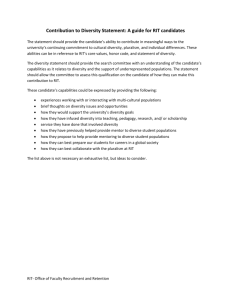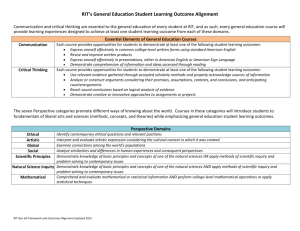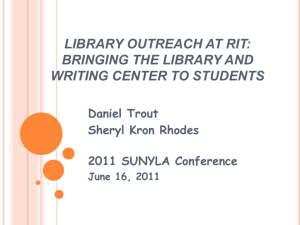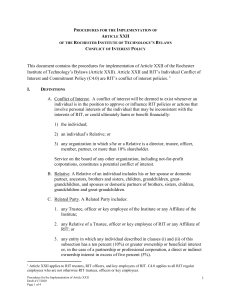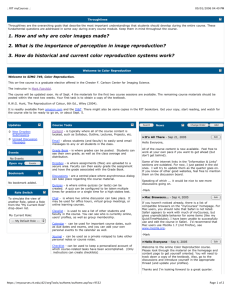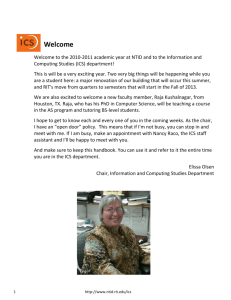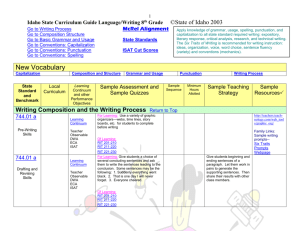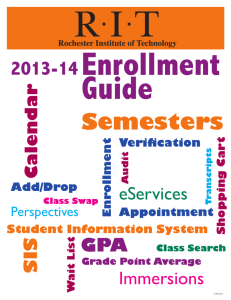Charge for Academic Technology Task Force
advertisement
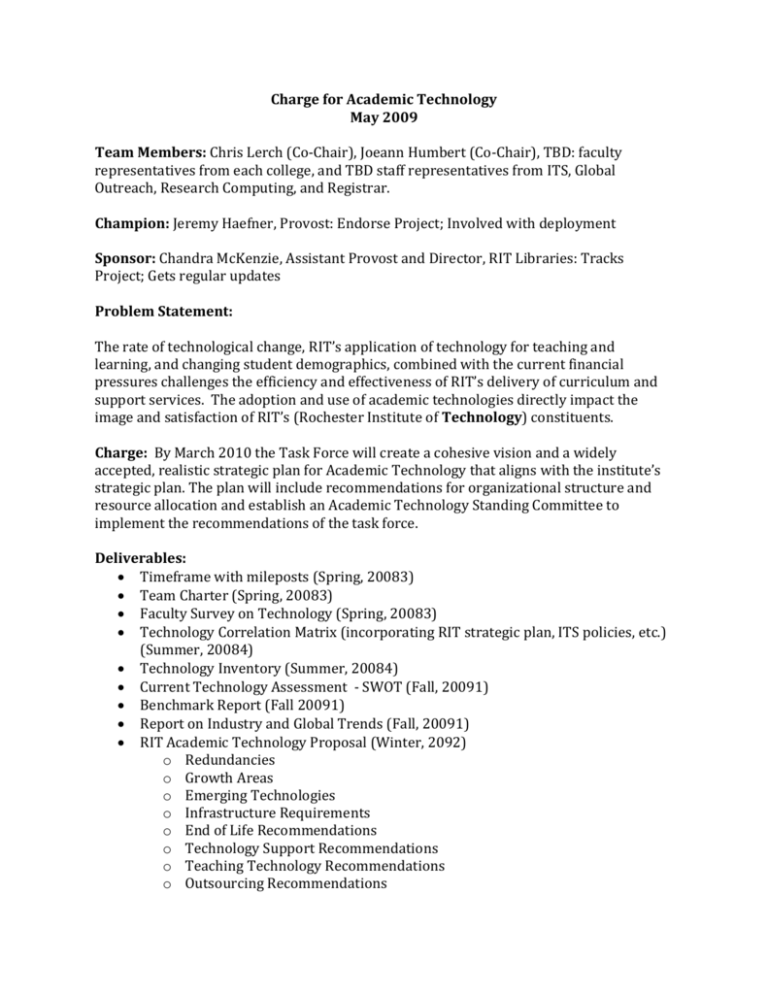
Charge for Academic Technology May 2009 Team Members: Chris Lerch (Co-Chair), Joeann Humbert (Co-Chair), TBD: faculty representatives from each college, and TBD staff representatives from ITS, Global Outreach, Research Computing, and Registrar. Champion: Jeremy Haefner, Provost: Endorse Project; Involved with deployment Sponsor: Chandra McKenzie, Assistant Provost and Director, RIT Libraries: Tracks Project; Gets regular updates Problem Statement: The rate of technological change, RIT’s application of technology for teaching and learning, and changing student demographics, combined with the current financial pressures challenges the efficiency and effectiveness of RIT’s delivery of curriculum and support services. The adoption and use of academic technologies directly impact the image and satisfaction of RIT’s (Rochester Institute of Technology) constituents. Charge: By March 2010 the Task Force will create a cohesive vision and a widely accepted, realistic strategic plan for Academic Technology that aligns with the institute’s strategic plan. The plan will include recommendations for organizational structure and resource allocation and establish an Academic Technology Standing Committee to implement the recommendations of the task force. Deliverables: Timeframe with mileposts (Spring, 20083) Team Charter (Spring, 20083) Faculty Survey on Technology (Spring, 20083) Technology Correlation Matrix (incorporating RIT strategic plan, ITS policies, etc.) (Summer, 20084) Technology Inventory (Summer, 20084) Current Technology Assessment - SWOT (Fall, 20091) Benchmark Report (Fall 20091) Report on Industry and Global Trends (Fall, 20091) RIT Academic Technology Proposal (Winter, 2092) o Redundancies o Growth Areas o Emerging Technologies o Infrastructure Requirements o End of Life Recommendations o Technology Support Recommendations o Teaching Technology Recommendations o Outsourcing Recommendations o Training Recommendations o Recommendations for the charter of a Standing Team Scope Includes: We are addressing technologies developed, supported, pseudosupported, or maintained within Academic Affairs units; many of which utilize ITS infrastructure technologies to do so. This may include technology research, selection, interoperability evaluation, deployment planning, and deployment execution of technological solutions RIT invents/creates or purchases/licenses. Items out of scope include ITS infrastructure (bandwidth delivery, landline voice, firewalls, etc.). Scale Includes: The strategic plan should identify and create a campus and global process for support of an array of academic technologies, those used by faculty, students and staff directly, as well as those utilized within Academic Affairs to support operations. Background and Purpose (Context): The complexities of RIT’s academic computing environments warrant a Provost task force initiative to review current and planned activities among various groups in Academic Affairs and to make recommendations to the Provost for action. We need a plan that will inform and support our practice as we address the rapid pace of technology advances, changing student demographics, and the technology to support our global outreach. A cohesive vision and strategic planning will help to guide individuals and units as they provide support, maintain quality services and pursue innovation despite increasing costs and financial exigency. The time is right: we have the energy and momentum of a new leadership and we face many opportunities and challenges that will be best served by a collaborative, thoughtful approach to academic technology. On one hand, we witness the power in the effective use of technology to reach and teach students: learning by media literacy, virtual worlds, distance, blended and technology enhanced courses, mobile learning through the use of tools such as webinars, wikis, courseware management tools, blogs, cell phones, GPS units, incubator classrooms, etc. Collections are being digitized at exponential rates as books, journals, images and videos are brought online and repositories created for archival and retrieval. New discovery tools are being developed to provide efficient access to the flood of digital information to support research and teaching. On the other, the choices are overwhelming for most individuals and it is unrealistic to provide support for all technologies or expect that faculty take on the responsibility to investigate every tool. These tools require us to build on existing teaching skills, and establish strategies and resources to support teaching and learning at RIT. There is expertise in the various technology departments at RIT and we need a process that will access them all when making important decisions and eliminate the redundancies where appropriate. Staff from the combined areas of the Library and Teaching and Learning Services have a long history as leaders in effectively and efficiently applying technology to support faculty and student success. We also possess a deep understanding of current and emerging technologies and their application to teaching and learning. Adding other critical individuals with expertise from invested departments to the planning group would assure a report and recommendations that are based on a comprehensive understanding of the current situation while creating a common, dedicated community to implement and support on-going change. Requirements: 1. Target date: Report completed, March 2010 2. Recommendations must be in alignment with the vision/mission of the Provost’s Office and strategic plan of RIT. 3. Recommendations should include resources needed for development and implementation. 4. On-going project review meetings with sponsor. Guiding questions: 1. What are the technologies supported within Academic Affairs? 2. What units are responsible for supporting the technology? 3. What units allocate the funds to maintain, replace, or upgrade the technology? 4. What replacement/upgrade/enhancement schedules presently exist? 5. What unique technologies (specific applications and requirements) exist that do not utilize ITS infrastructure? 6. What are appropriate processes to encourage innovation and experimentation with teaching and learning technologies? Milestones: End of Spring Quarter, 20083 (Definition Phase) o Convene team, approve charter o Draft of faculty survey o Formation of Summer sub-teams End of Summer Quarter 20084 (Measure I Phase) o Faculty technology use survey summary o Technology inventory o Technology correlation matrix End of Fall Quarter 20091 (Measure II Phase) o Current technology assessment (SWOT) o Benchmark Report o Report on industry and global trends End of Winter Quarter 20092 (Analysis Phase) o Deliver Academic Technology proposal o Establish Standing Committee Spring Quarter 20093 (Implementation Phase) o Generate early successes and establish detailed long term plans Concerns/Risks: Amount/distribution of faculty time Buy-in and support from tech people Compensation for faculty Summer work schedule We want meetings to focus on analyzing data and making decisions; use wikis and other tools for detailed communications and information sharing. We want to restrict communication time in meetings to review of action items and tasks. Project scope huge—want to break into manageable pieces and ensure some early success.


